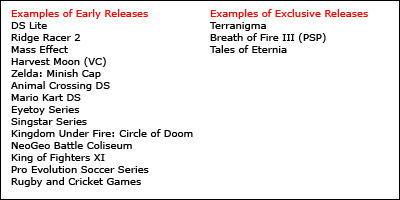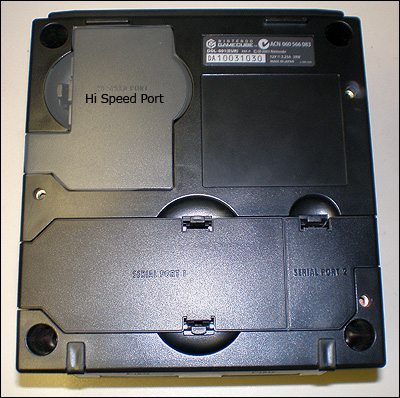Super Mario World:: The Pinnacle of 2D Plumber Platforming
March 15th, 2008

Theres been plenty of hearty debate over which 2D Mario game rules them all. With the release of Super Mario Galaxy this brought about even more discussion. I was never really interested in these debates despite being a lime long Mario fanboy. But after reading the Super Mario World page in The 100 Best Video Games I thought that they mentioned a few good ideas that I want to expand upon.
The Rules
Okay, a few things need to be made clear. We are only referring to true Mario platformers, so this doesn’t include:
- Yoshis Island
- Super Mario Bros 2
- Super Mario Land 3
- Hotel Mario
- the Edutainment Mario games
- Super Mario All Stars (no compilations)
- Lost Levels (or Japanese only games)
Now, the question at hand is “What is the best 2D Mario platformer?”.
So with these rules in mind, here are the list of possible candidates:
- Super Mario Bros
- Super Mario Bros 3
- Super Mario Land
- Super Mario Land 2
- Super Mario World
- New Super Mario Bros
To kick thing off we can cross off New Super Mario Bros. The game just didn’t live up to the other games in the series. The level design wasn’t as clever, the game was overall far too easy and although it introduces those giant mushrooms it lacked the better abilities from the other Mario games such as the cape, frog suit and Yoshi.
Although they are awesome games and generally do get overlooked during these arguments, I’m going to have to disregard the Gameboy Mario games. Their main strength comes from miniaturizing the console titles rather than pushing the series forward. Gunpei Yokoi also headed up these titles, although I liked how his games didn’t feel like conventional mushroom kingdom games, it did make the games feel somewhat out of line with the Mario universe. Plus they introduced Princess Daisy which made things way too confusing. But then again the sequel did introduce Wario. I guess we can overlook this then ^_^
So we are down to the lastthree: Super Mario Bros, Super Mario Bros 3 and Super Mario World. Out of these three games SMW is the least innovative. Super Mario Bros started it all, Super Mario Bros 3 took it to an all new level and Super Mario World polished it to perfection.
As the rules state, we are after the BEST game. Therefore Super Mario World must win. Despite how ground breaking the other games were, SMW is the most polished and perfected game in the series. It is bigger, better and more refined than its predecessors. Which ultimately makes it the best 2D Mario platformer in existence.
Five Advantages of Being a PAL Gamer
March 13th, 2008

This article was originally titled “The Top 10 Advantages of Being a PAL Gamer” but as you might have guessed I fell short at five.
There is a long tradition in the video game industry with consumers and the PAL encoding system. That is people whom live in PAL territories (that is Europe, Australia, New Zealand among others) more often than not end up drawing the short straw. Unlike our NTSC counterparts it often takes a long time for new technology to reach our shores and even when it does our price is marked up, we have lower distribution numbers and often receive modified/downgraded content. Basically it is the manufacturer’s way of telling us that we are simply not a priority for them.
On the rare occasion though us PAL gamers might be treated to something that trumps our American and Japanese friends. These special treats are rare cases indeed, thinking up even a measly five perks has been a formidable challenge. But the advantages are there, just a little hard to find. ^_^
I’d also like to thank the forum members over at PALGN whom suggested a few ideas and helped with the brainstorming process.
Early/Exclusive Releases
Although it had taken a long time for this trend to set in, occasionally in the industry you will notice that some PAL (especially European and Australian) games are released a few days earlier than their respective American counterpart. Fifteen years ago, excluding European developed games this trend was not existent but in the past 6 years early European releases have taken off and continue to occur quite frequently.
There are a couple of reasons as to why this situation is turning around. Firstly the increase of European game development. Take a flick through the back of any EDGE magazine and you will notice just how many AAA developers are situated in the UK. Then there is the strength of the Playstation brand in PAL territories.
I could fill a whole separate article on the latter point but I will try to be brief here. Basically for years game companies had neglected the PAL markets. When the Playstation was produced, the situation started to slowly change. Sony actually viewed and treated the PAL market for what it was; a solid, viable area for strong game sales. Hence it didn’t take much for Sony to become and still maintain the European market with it’s Playstation brand.
Years later, prior to the release of the Gamecube, Nintendo Europe was noticing slow adoption rates of Nintendo consoles compared to other territories. NOE representatives admitted that the UK markets had been previously neglected by Nintendo (release dates particularly) and in an attempt to turn the tides they changed the way that they viewed Europe and PAL territories. As a result the UK started to see several earlier releases for significant Gamecube and GBA titles, some games even launched first in Europe and then to the rest of the world. In the meantime Phil Harrison (of Sony Computer Entertainment Europe) pushed for a greater emphasis on mass market Playstation 2 devices (Eye Toy, Buzz, Singstar etc.). This payed off for Sony and these games were and still are a huge success in the UK and Australia. The success of these titles (as well as Nintendo’s new found interest in Europe) ensured that earlier PAL releases would continue to occur and have done so ever since.
Along with this, PAL territories do occasionally receive PAL exclusive titles and they are listed as well:

Speculating over the Original Intentions Behind the Gamecube’s Hi-Speed Port
March 10th, 2008

Got a GameCube? Ever wondered what that Hi-Speed port on the bottom of the Cube was really all about? You know this one:

Back around the time the Gamecube and it’s hardware specifications were first being shown off at E3 2001 Nintendo stated that the Hi-Speed port was basically a port for any console add-ons or peripherals down the track and that for the time being they weren’t sure what any of these expansions may be. I can’t remember exactly but I believe that the default assumption was that it would be similar to the Nintendo 64’s Memory Expansion port which later housed the Expansion Pak. That is, some sort of additional processing power for the console.
Eventually a year and a half later Nintendo released the GameBoy Player which was the only such peripheral to ever take advantage of this port. Which kinda makes me a little suspect as to what Nintendo were originally planning to use the port for. So I’ve thrown together some ideas of my own which I think would have been realistic of Nintendo and the hardware, feasible as well as useful for the consumer.
CPU or RAM Upgrade
Much like the N64’s Expansion Pak the Hi-Speed port would have likely been some sort of small upgrade to the system to give it an added advantage in whatever Nintendo could have considered the Gamecube was lacking.
There are two reasons why I believe this is likely firstly Nintendo’s history with expanding a consoles hardware. With the Super Nintendo they used a series of chip upgrades to the game cartridges and with the Nintendo 64 they had the expansion pak, so a further opportunity to upgrade their platform’s hardware is logically sound. Secondly the name Hi-Speed gives the hint that whatever plugs into it will add “speed” or power to the console.
Harddrive
Remember the Memory Card 59s and how annoying they were? Then Nintendo finally released the 251 followed by the 1019 and finally the 2043. It is so ridiculous and confusing. You know that they messed up because they kept on releasing games with free memory cards. In anycase a portable harddrive would have solved all of these problems.
Judging from my own perception, from the size of the Hi-Speed compartment and the technology back 5 years ago a small 128mb harddrive would have definitely been feasible . That is equivalent to a Memory Card 2043 by the way.
Obviously Nintendo didn’t put much effort into putting the Gamecube online so really the harddrive would have just been an “invisible” storage unit (rather then used to store additional content). Which isn’t such a bad idea for someone like myself whom has roughly 6 GameCube Memory cards. Once again this one is quite likely, firstly because Nintendo had the issue of memory card storage and secondly because the Hi-Speed port was a Parallel port which is old technology used (superseded by USB technology) for floppy disks, portable harddrives etc.
DVD Player
 This is another technology new to Nintendo which often conflicted them. On one hand Nintendo didn’t want a DVD player for the Gamecube but on the other it released the Panasonic Q in Japan which was a metallic, silver Gamecube with a small LCD screen and DVD player.
This is another technology new to Nintendo which often conflicted them. On one hand Nintendo didn’t want a DVD player for the Gamecube but on the other it released the Panasonic Q in Japan which was a metallic, silver Gamecube with a small LCD screen and DVD player.
This is where I believe a DVD player add on could have been in the works. Nintendo has a good relationship with Matsushita and had plenty of reasons to include a DVD player. The main reason being that people liked the idea of having a “free” DVD player with their console. I believe that if this one was to have taken off then it would had a similar design to the GB Player.
Wii-like Peripherals
Yes, yes we do like peripherals. Or so I believe Iwata-San (back then he had just overthrown replaced Hiroshi Yamuachi) was saying. This one is going to be difficult to prove because I can’t quite remember it myself. But I vaguely remember that once before when questioned about N5 (the code name for the Wii) Iwata stated that he wanted to add further life into the Gamecube with additional peripherals.
There is a relationship here and I hope that you have spotted it. ^_^
Basically these peripheral never really were released on the Gamecube (you could say otherwise with the microphone, bongos etc) and migrated over to the Wii. The Wii Zapper, Balance Board and even the Wii mote itself are all examples of what these Gamecube peripherals could have originally intended to be. It does make a lot of sense. Hence I believe that this would have been another likely idea being kicked around over at NCL. Now if only I could back that claim up. ><



 Game Design Companion: A Critical Analysis of Wario Land 4 - $7.99
Game Design Companion: A Critical Analysis of Wario Land 4 - $7.99 Level Design: Processes and Experiences
Level Design: Processes and Experiences Speed Boost: The Hidden Secrets Behind Arcade Racing Design - $5.99
Speed Boost: The Hidden Secrets Behind Arcade Racing Design - $5.99 Adventures in Games Analysis: Volume I - $5.99
Adventures in Games Analysis: Volume I - $5.99







